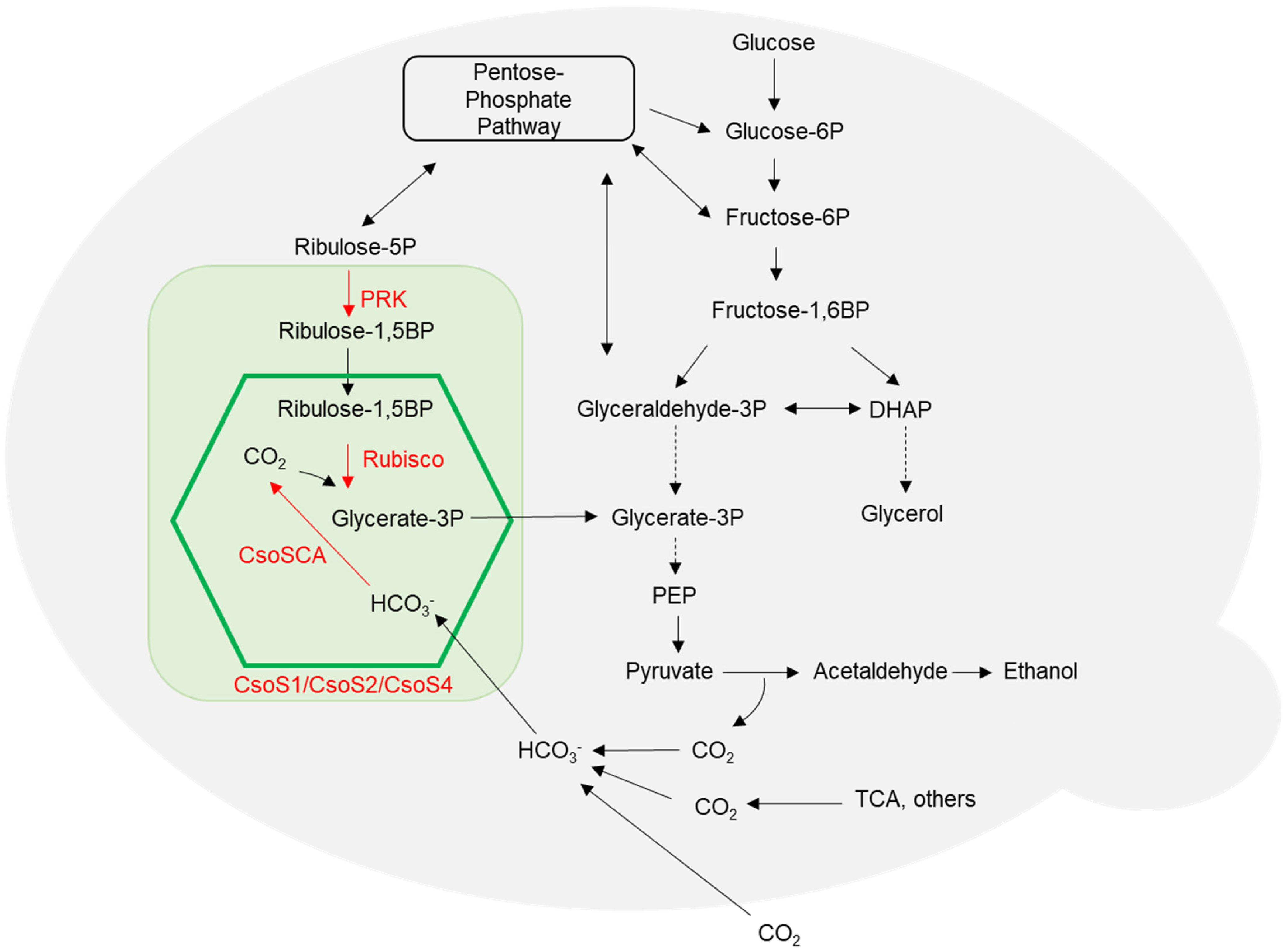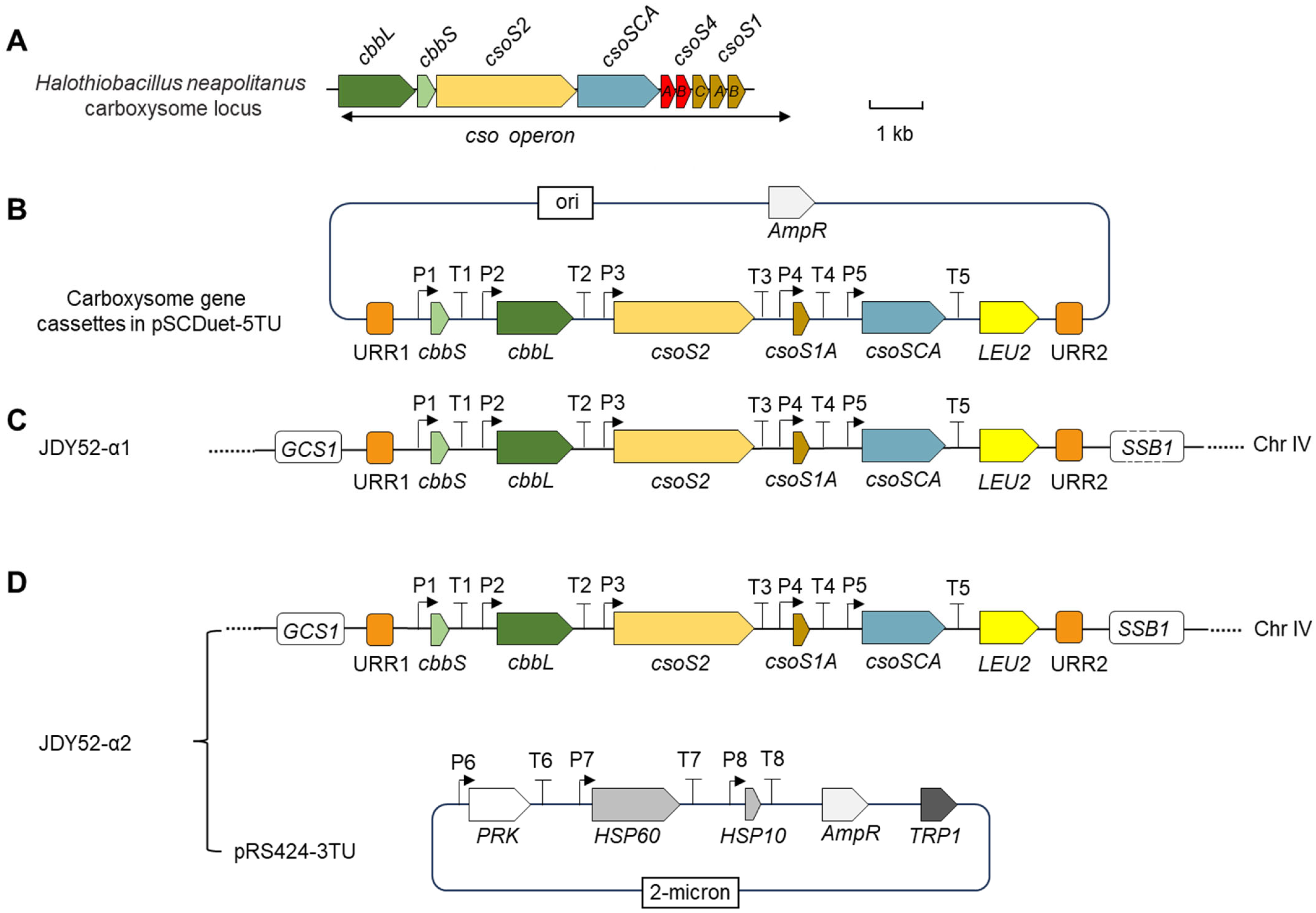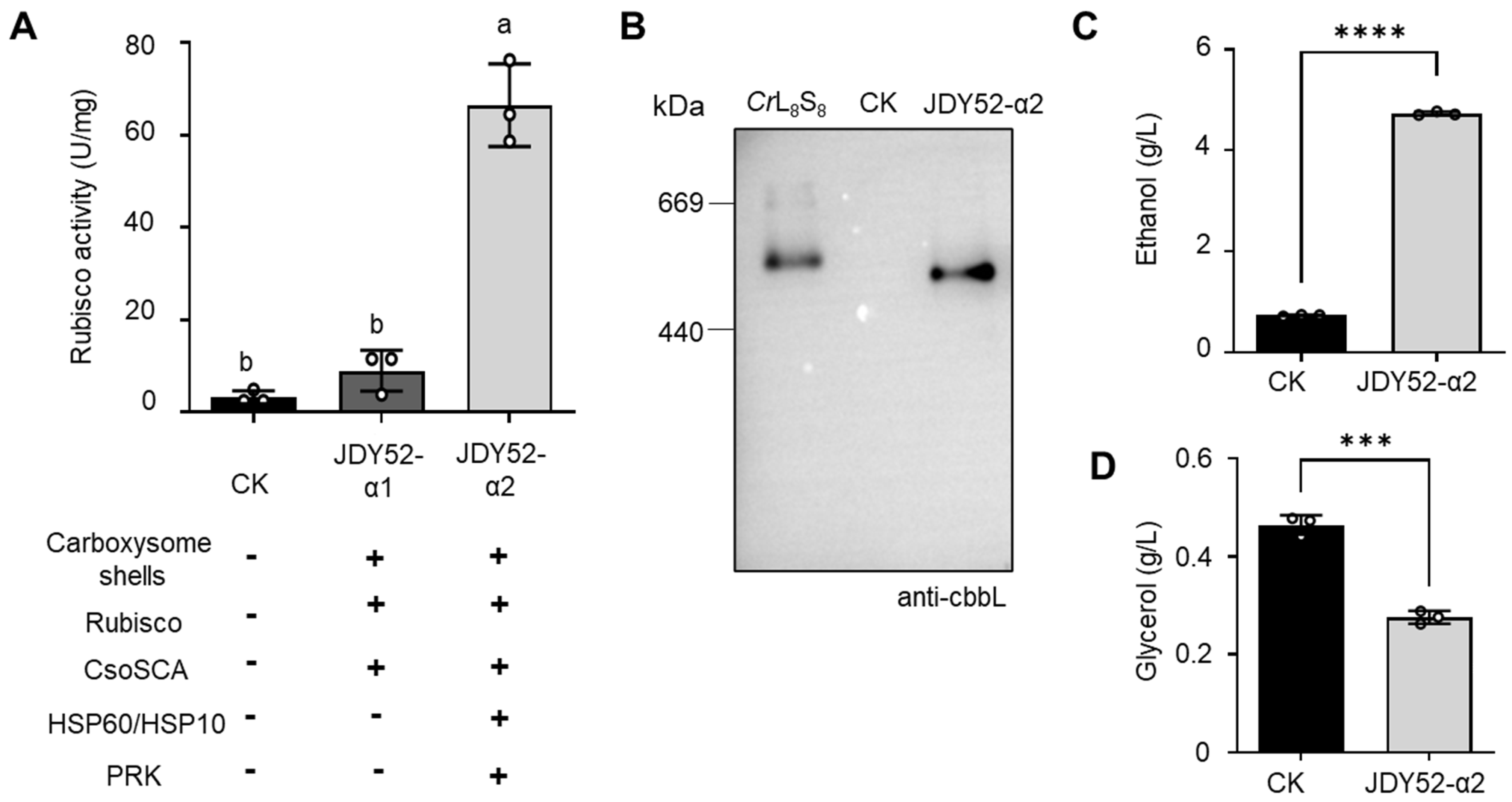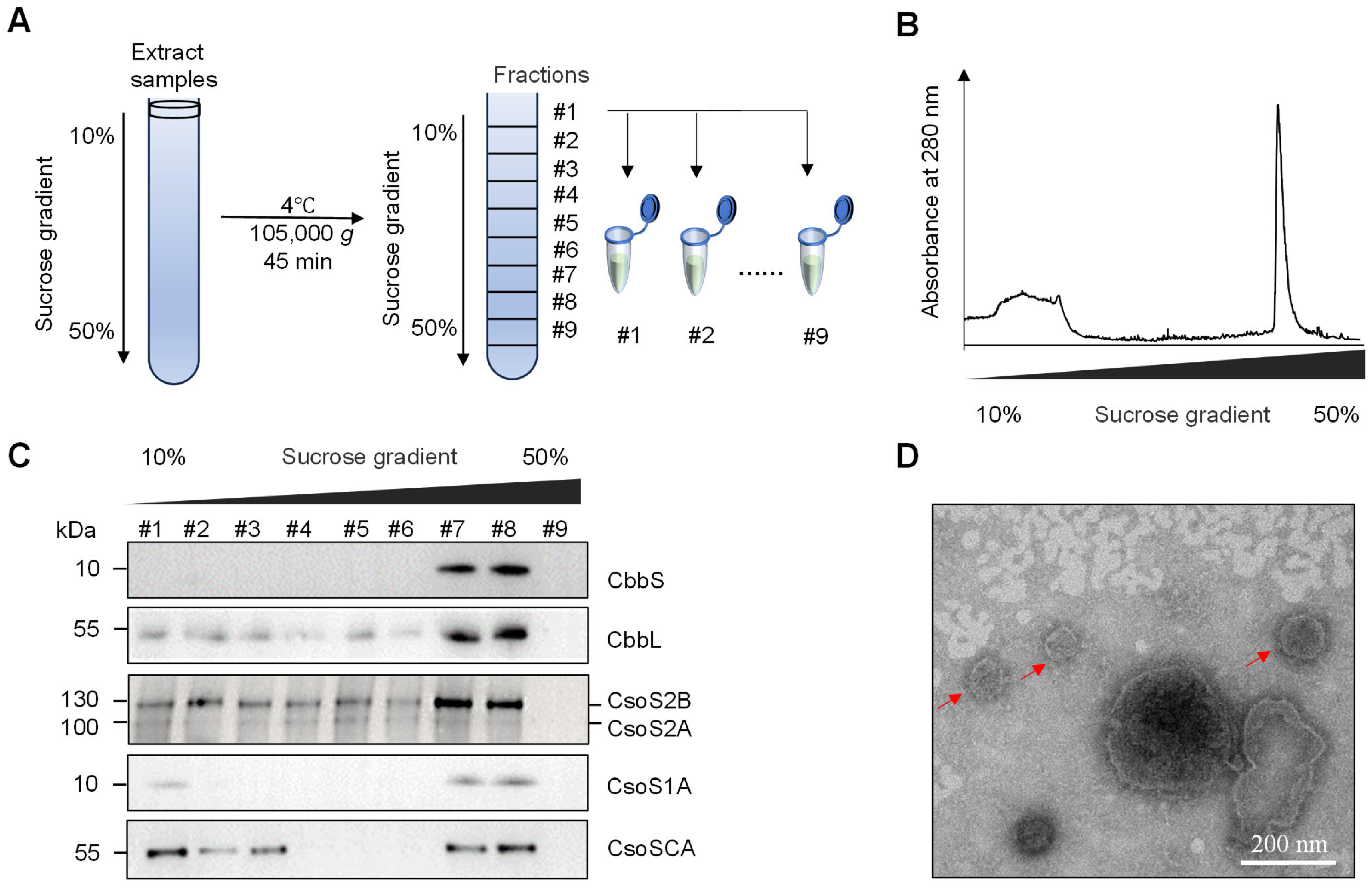Engineering CO2-Fixing Carboxysome into Saccharomyces cerevisiae to Improve Ethanol Production
Abstract
1. Introduction
2. Results
2.1. Heterologous Expression of α-Carboxysome Genes in S. cerevisiae
2.2. Construction of CO2-Fixing S. cerevisiae by Expression of Chaperones and Phosphoribulokinase
2.3. Functional Expression and Assembly of Rubisco in S. cerevisiae
2.4. Characterization of Carboxysome-like Structures
3. Discussion
4. Materials and Methods
4.1. Construction of Plasmids and Yeast Strains
4.2. Rubisco Enzymatic Activity Assay
4.3. Fermentation Conditions and HPLC Analysis
4.4. Fluorescence Microscopy
4.5. Purification of α-Carboxysomes from S. cerevisiae
4.6. Statistical Analysis
Supplementary Materials
Author Contributions
Funding
Data Availability Statement
Acknowledgments
Conflicts of Interest
References
- Giessen, T.W.; Silver, P.A. A catalytic nanoreactor based on in vivo encapsulation of multiple enzymes in an engineered protein nanocompartment. ChemBioChem 2016, 17, 1931–1935. [Google Scholar] [CrossRef]
- Hammer, S.K.; Avalos, J.L. Harnessing yeast organelles for metabolic engineering. Nat. Chem. Biol. 2017, 13, 823–832. [Google Scholar] [CrossRef] [PubMed]
- Kerfeld, C.A.; Erbilgin, O. Bacterial microcompartments and the modular construction of microbial metabolism. Trends Microbiol. 2015, 23, 22–34. [Google Scholar] [CrossRef] [PubMed]
- Rae, B.D.; Long, B.M.; Badger, M.R.; Price, G.D. Functions, compositions, and evolution of the two types of carboxysomes: Polyhedral microcompartments that facilitate CO2 fixation in cyanobacteria and some proteobacteria. Microbiol. Mol. Biol. Rev. 2013, 77, 357–379. [Google Scholar] [CrossRef] [PubMed]
- Tanaka, S.; Kerfeld, C.A.; Sawaya, M.R.; Cai, F.; Heinhorst, S.; Cannon, G.C.; Yeates, T.O. Atomic-level models of the bacterial carboxysome shell. Science 2008, 319, 1083–1086. [Google Scholar] [CrossRef]
- Liu, L.N. Advances in the bacterial organelles for CO2 fixation. Trends Microbiol. 2022, 30, 567–580. [Google Scholar] [CrossRef]
- Oltrogge, L.M.; Chaijarasphong, T.; Chen, A.W.; Bolin, E.R.; Marqusee, S.; Savage, D.F. Multivalent interactions between CsoS2 and Rubisco mediate α-carboxysome formation. Nat. Struct. Mol. Biol. 2020, 27, 281–287. [Google Scholar] [CrossRef]
- Li, T.; Jiang, Q.; Huang, J.; Aitchison, C.M.; Huang, F.; Yang, M.; Dykes, G.F.; He, H.L.; Wang, Q.; Sprick, R.S.; et al. Reprogramming bacterial protein organelles as a nanoreactor for hydrogen production. Nat. Commun. 2020, 11, 5448. [Google Scholar] [CrossRef]
- Kerfeld, C.A.; Aussignargues, C.; Zarzycki, J.; Cai, F.; Sutter, M. Bacterial microcompartments. Nat. Rev. Microbiol. 2018, 16, 277–290. [Google Scholar] [CrossRef]
- Bonacci, W.; Teng, P.K.; Afonso, B.; Niederholtmeyer, H.; Grob, P.; Silver, P.A.; Savage, D.F. Modularity of a carbon-fixing protein organelle. Proc. Natl. Acad. Sci. USA 2012, 109, 478–483. [Google Scholar] [CrossRef]
- Baumgart, M.; Huber, I.; Abdollahzadeh, I.; Gensch, T.; Frunzke, J. Heterologous expression of the Halothiobacillus neapolitanus carboxysomal gene cluster in Corynebacterium glutamicum. J. Biotechnol. 2017, 258, 126–135. [Google Scholar] [CrossRef]
- Flamholz, A.I.; Dugan, E.; Blikstad, C.; Gleizer, S.; Ben-Nissan, R.; Amram, S.; Antonovsky, N.; Ravishankar, S.; Noor, E.; Bar-Even, A.; et al. Functional reconstitution of a bacterial CO2 concentrating mechanism in Escherichia coli. eLife 2020, 9, e59882. [Google Scholar] [CrossRef]
- Ni, T.; Jiang, Q.; Ng, P.C.; Shen, J.; Dou, H.; Zhu, Y.; Radecke, J.; Dykes, G.F.; Huang, F.; Liu, L.N.; et al. Intrinsically disordered CsoS2 acts as a general molecular thread for α-carboxysome shell assembly. Nat. Commun. 2023, 14, 5512. [Google Scholar] [CrossRef]
- Kim, S.R.; Kim, S.J.; Kim, S.K.; Seo, S.O.; Park, S.; Shin, J.; Kim, J.S.; Park, B.R.; Jin, Y.S.; Chang, P.S.; et al. Yeast metabolic engineering for carbon dioxide fixation and its application. Bioresour. Technol. 2022, 346, 126349. [Google Scholar] [CrossRef] [PubMed]
- Guadalupe-Medina, V.; Wisselink, H.W.; Luttik, M.A.; de Hulster, E.; Daran, J.M.; Pronk, J.T.; van Maris, A.J. Carbon dioxide fixation by Calvin-cycle enzymes improves ethanol yield in yeast. Biotechnol. Biofuels 2013, 6, 125. [Google Scholar] [CrossRef] [PubMed]
- Xia, P.F.; Zhang, G.C.; Walker, B.; Seo, S.O.; Kwak, S.; Liu, J.J.; Kim, H.; Ort, D.R.; Wang, S.G.; Jin, Y.S. Recycling carbon dioxide during xylose fermentation by engineered Saccharomyces cerevisiae. ACS Synth. Biol. 2017, 6, 276–283. [Google Scholar] [CrossRef] [PubMed]
- Li, Y.J.; Wang, M.M.; Chen, Y.W.; Wang, M.; Fan, L.H.; Tan, T.W. Engineered yeast with a CO2-fixation pathway to improve the bio-ethanol production from xylose-mixed sugars. Sci. Rep. 2017, 7, 43875. [Google Scholar] [CrossRef]
- Long, B.M.; Hee, W.Y.; Sharwood, R.E.; Rae, B.D.; Kaines, S.; Lim, Y.L.; Nguyen, N.D.; Massey, B.; Bala, S.; von Caemmerer, S.; et al. Carboxysome encapsulation of the CO2-fixing enzyme Rubisco in tobacco chloroplasts. Nat. Commun. 2018, 9, 3570. [Google Scholar] [CrossRef]
- Guo, Y.; Dong, J.; Zhou, T.; Auxillos, J.; Li, T.; Zhang, W.; Wang, L.; Shen, Y.; Luo, Y.; Zheng, Y.; et al. YeastFab: The design and construction of standard biological parts for metabolic engineering in Saccharomyces cerevisiae. Nucleic Acids Res. 2015, 43, e88. [Google Scholar] [CrossRef]
- Chaijarasphong, T.; Nichols, R.J.; Kortright, K.E.; Nixon, C.F.; Teng, P.K.; Oltrogge, L.M.; Savage, D.F. Programmed ribosomal frameshifting mediates expression of the α-carboxysome. J. Mol. Biol. 2016, 428, 153–164. [Google Scholar] [CrossRef]
- Höhfeld, J.; Hartl, F.U. Role of the chaperonin cofactor Hsp10 in protein folding and sorting in yeast mitochondria. J. Cell Biol. 1994, 126, 305–315. [Google Scholar] [CrossRef]
- Johnson, R.B.; Fearon, K.; Mason, T.; Jindal, S. Cloning and characterization of the yeast chaperonin HSP60 gene. Gene 1989, 84, 295–302. [Google Scholar] [CrossRef] [PubMed]
- Reading, D.S.; Hallberg, R.L.; Myers, A.M. Characterization of the yeast HSP60 gene coding for a mitochondrial assembly factor. Nature 1989, 337, 655–659. [Google Scholar] [CrossRef] [PubMed]
- Rospert, S.; Glick, B.S.; Jenö, P.; Schatz, G.; Todd, M.J.; Lorimer, G.H.; Viitanen, P.V. Identification and functional analysis of chaperonin 10, the groES homolog from yeast mitochondria. Proc. Natl. Acad. Sci. USA 1993, 90, 10967–10971. [Google Scholar] [CrossRef] [PubMed]
- Gassler, T.; Sauer, M.; Gasser, B.; Egermeier, M.; Troyer, C.; Causon, T.; Hann, S.; Mattanovich, D.; Steiger, M.G. The industrial yeast Pichia pastoris is converted from a heterotroph into an autotroph capable of growth on CO2. Nat. Biotechnol. 2020, 38, 210–216. [Google Scholar] [CrossRef]
- Brandes, H.K.; Hartman, F.C.; Lu, T.Y.; Larimer, F.W. Efficient expression of the gene for spinach phosphoribulokinase in Pichia pastoris and utilization of the recombinant enzyme to explore the role of regulatory cysteinyl residues by site-directed mutagenesis. J. Biol. Chem. 1996, 271, 6490–6496. [Google Scholar] [CrossRef]
- Milanez, S.; Mural, R.J. Cloning and sequencing of cDNA encoding the mature form of phosphoribulokinase from spinach. Gene 1988, 66, 55–63. [Google Scholar] [CrossRef]
- Chen, T.; Riaz, S.; Davey, P.; Zhao, Z.; Sun, Y.; Dykes, G.F.; Zhou, F.; Hartwell, J.; Lawson, T.; Nixon, P.J.; et al. Producing fast and active Rubisco in tobacco to enhance photosynthesis. Plant Cell 2023, 35, 795–807. [Google Scholar] [CrossRef]
- Taylor, T.C.; Backlund, A.; Bjorhall, K.; Spreitzer, R.J.; Andersson, I. First crystal structure of Rubisco from a green alga, Chlamydomonas reinhardtii. J. Biol. Chem. 2001, 276, 48159–48164. [Google Scholar] [CrossRef]
- Sun, Y.; Harman, V.M.; Johnson, J.R.; Brownridge, P.J.; Chen, T.; Dykes, G.F.; Lin, Y.; Beynon, R.J.; Liu, L.N. Decoding the absolute stoichiometric composition and structural plasticity of α-carboxysomes. mBio 2022, 13, e0362921. [Google Scholar] [CrossRef]
- Wiederhold, E.; Veenhoff, L.M.; Poolman, B.; Slotboom, D.J. Proteomics of Saccharomyces cerevisiae organelles. Mol. Cell. Proteom. 2010, 9, 431–445. [Google Scholar] [CrossRef]
- Bertels, L.K.; Fernández Murillo, L.; Heinisch, J.J. The pentose phosphate pathway in yeasts–More than a poor cousin of glycolysis. Biomolecules 2021, 11, 725. [Google Scholar] [CrossRef] [PubMed]
- Chen, T.; Fang, Y.; Jiang, Q.; Dykes, G.F.; Lin, Y.; Price, G.D.; Long, B.M.; Liu, L.N. Incorporation of functional Rubisco activases into engineered carboxysomes to enhance carbon fixation. ACS Synth. Biol. 2022, 11, 154–161. [Google Scholar] [CrossRef] [PubMed]
- Jiang, S.; Luo, Z.; Dai, J. Use YeastFab to construct genetic parts and multicomponent pathways for metabolic engineering. Methods Mol. Biol. 2021, 2196, 167–180. [Google Scholar] [PubMed]
- Heinhorst, S.; Williams, E.B.; Cai, F.; Murin, C.D.; Shively, J.M.; Cannon, G.C. Characterization of the carboxysomal carbonic anhydrase CsoSCA from Halothiobacillus neapolitanus. J. Bacteriol. 2006, 188, 8087–8094. [Google Scholar] [CrossRef]
- Pemberton, L.F. Preparation of yeast cells for live-cell imaging and indirect immunofluorescence. Methods Mol. Biol. 2014, 1205, 79–90. [Google Scholar]
- Hu, Y.; Li, H.; He, C.W.; Zhu, Q.; Xie, Z.P. Construction of a Yeast Strain for the Evaluation of Subcellular Fractionation. China Biotechnol. 2020, 40, 10–23. [Google Scholar]
- Rieder, S.E.; Emr, S.D. Isolation of subcellular fractions from the yeast Saccharomyces cerevisiae. Curr. Protoc. Cell Biol. 2001, 8, 3–8. [Google Scholar]
- Chen, T.; Hojka, M.; Davey, P.; Sun, Y.; Dykes, G.F.; Zhou, F.; Lawson, T.; Nixon, P.J.; Lin, Y.; Liu, L.N. Engineering α-carboxysomes into plant chloroplasts to support autotrophic photosynthesis. Nat. Commun. 2023, 14, 2118. [Google Scholar] [CrossRef]





Disclaimer/Publisher’s Note: The statements, opinions and data contained in all publications are solely those of the individual author(s) and contributor(s) and not of MDPI and/or the editor(s). MDPI and/or the editor(s) disclaim responsibility for any injury to people or property resulting from any ideas, methods, instructions or products referred to in the content. |
© 2025 by the authors. Licensee MDPI, Basel, Switzerland. This article is an open access article distributed under the terms and conditions of the Creative Commons Attribution (CC BY) license (https://creativecommons.org/licenses/by/4.0/).
Share and Cite
Li, M.; Zeng, S.; Guo, Y.; Ji, J.; Fan, Q.; Duanmu, D. Engineering CO2-Fixing Carboxysome into Saccharomyces cerevisiae to Improve Ethanol Production. Int. J. Mol. Sci. 2025, 26, 9759. https://doi.org/10.3390/ijms26199759
Li M, Zeng S, Guo Y, Ji J, Fan Q, Duanmu D. Engineering CO2-Fixing Carboxysome into Saccharomyces cerevisiae to Improve Ethanol Production. International Journal of Molecular Sciences. 2025; 26(19):9759. https://doi.org/10.3390/ijms26199759
Chicago/Turabian StyleLi, Mengqi, Simin Zeng, Yunling Guo, Jie Ji, Qiuling Fan, and Deqiang Duanmu. 2025. "Engineering CO2-Fixing Carboxysome into Saccharomyces cerevisiae to Improve Ethanol Production" International Journal of Molecular Sciences 26, no. 19: 9759. https://doi.org/10.3390/ijms26199759
APA StyleLi, M., Zeng, S., Guo, Y., Ji, J., Fan, Q., & Duanmu, D. (2025). Engineering CO2-Fixing Carboxysome into Saccharomyces cerevisiae to Improve Ethanol Production. International Journal of Molecular Sciences, 26(19), 9759. https://doi.org/10.3390/ijms26199759




